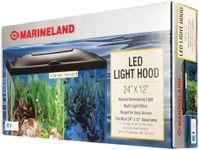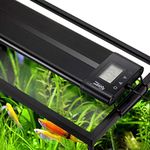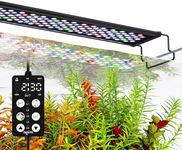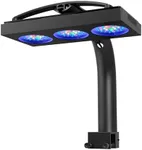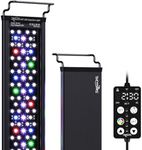Buying Guide for the Best Aquarium Lights
Choosing the right aquarium light is crucial for the health and well-being of your aquatic life. The right lighting not only enhances the beauty of your aquarium but also supports the growth of plants and the health of fish. When selecting aquarium lights, consider the type of aquarium you have, the needs of your aquatic plants and animals, and the overall aesthetic you want to achieve. Here are some key specifications to consider when choosing aquarium lights.Light SpectrumThe light spectrum refers to the range of light wavelengths emitted by the light source. This is important because different wavelengths support different biological processes. For example, blue light promotes photosynthesis in plants, while red light can enhance the coloration of fish. If you have a planted aquarium, look for lights that offer a full spectrum or are specifically designed for plant growth. For fish-only tanks, a light that enhances the colors of your fish may be more suitable.
Light IntensityLight intensity is the amount of light produced by the light source, usually measured in lumens or PAR (Photosynthetically Active Radiation). This is important because different plants and corals require different light intensities to thrive. Low light intensity is suitable for low-light plants and fish-only tanks, medium intensity is good for most freshwater plants, and high intensity is necessary for demanding plants and coral reefs. Assess the needs of your aquarium inhabitants to determine the appropriate light intensity.
Light DurationLight duration refers to how long the lights are on each day. This is important because both plants and fish have natural day and night cycles that need to be mimicked in the aquarium. Generally, 8-10 hours of light per day is sufficient for most aquariums. Some lights come with built-in timers or can be connected to external timers to help you manage the light duration easily. Consider the natural habitat of your aquarium inhabitants to set the appropriate light duration.
Light TypeThere are several types of aquarium lights, including LED, fluorescent, and metal halide. LED lights are energy-efficient, long-lasting, and offer a wide range of spectrums and intensities. Fluorescent lights are less expensive but may not last as long and can be less energy-efficient. Metal halide lights are very intense and are typically used for large or deep aquariums, especially those with coral reefs. Choose the light type that best fits the needs of your aquarium and your preferences for energy consumption and maintenance.
Size and CoverageThe size and coverage of the light refer to how well the light fits your aquarium and how evenly it illuminates the tank. This is important to ensure that all areas of the aquarium receive adequate light. Measure the dimensions of your aquarium and choose a light that matches its length and width. Some lights are adjustable or come with extendable brackets to fit different tank sizes. Ensure that the light provides even coverage to avoid dark spots and ensure all plants and animals receive sufficient light.
Heat OutputHeat output refers to the amount of heat generated by the light source. This is important because excessive heat can raise the water temperature, which can be harmful to your aquarium inhabitants. LED lights typically produce less heat compared to fluorescent and metal halide lights. If you choose a light that generates significant heat, you may need to invest in a cooling system or ensure proper ventilation. Consider the temperature requirements of your aquarium inhabitants when selecting a light with appropriate heat output.






